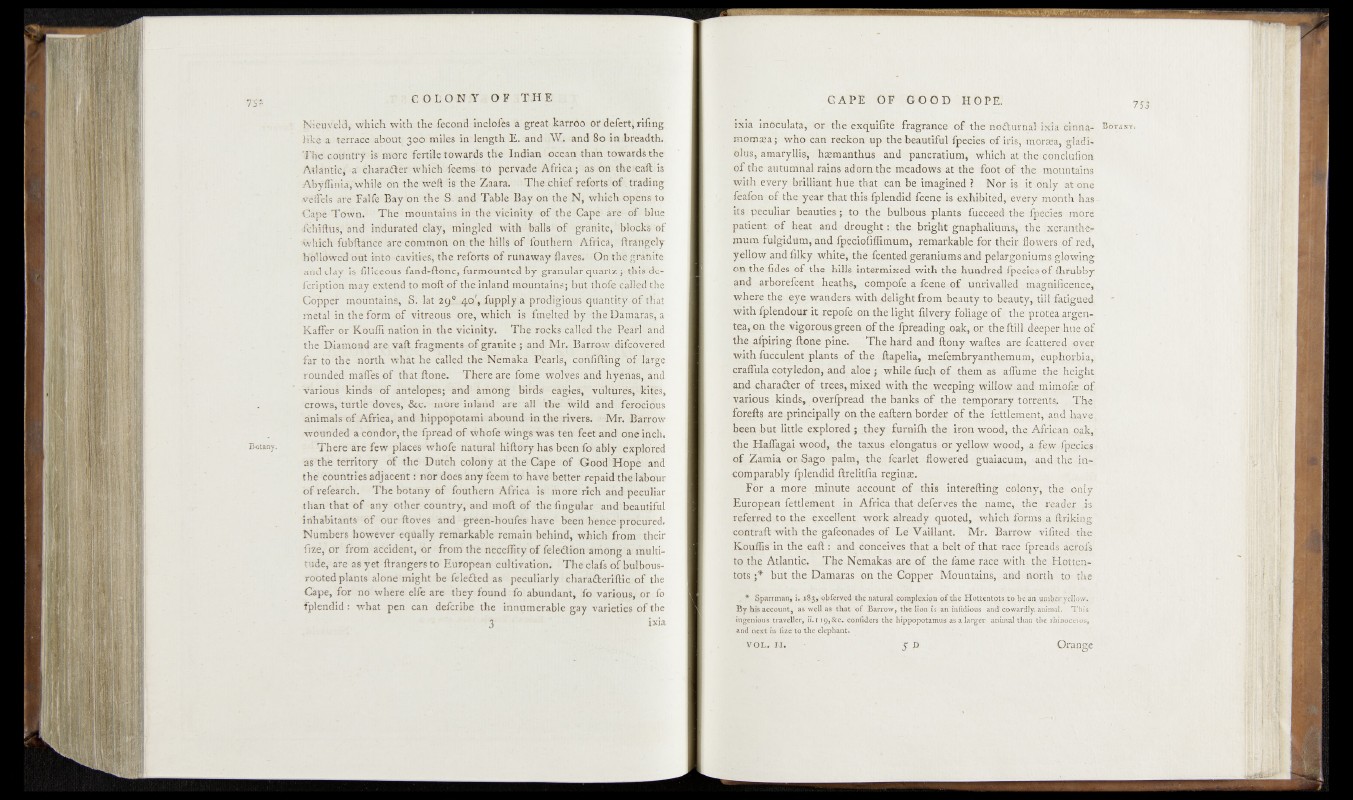
75'? COLONY OF T.H E
■ NieuVeldy which with, thefrcmfl: iöcfofes 'ai great (karroo ©tdefertfrifrag
üy» a if^ani&aAMTiitiK jan rnlies in lengtk E. attdi.W. and 80 ia breadth.
The coimtry-iS' ft®§rë fertiletowards the Indian: oceap thrin towards thq
Adantlè/'a- èhatsfétër which: Ie#öi^-t0 pervade Afrid&jt as ööthefeaftris
Abyffiniav'wMle ön the'Wëft.% the Zaara. É®hê^lQf feforts1of!, tijding
'fVCÏfeis aBi'Eaffë Bay tari?fliê''i8.and Table I|ay on the N, Whiibrfepèn# to
-■ Gapë TóWh.1 'FÉe-nftoiinÉai^dhJthévleiöity ^€^hef(3apé: k^-cÉ- 'bta.;e
lihhiftüs,- and indurated clay, rtiitagled w*ith b¥lfef%fl ^iöifëjhbfecïk^^óf
which füWlShêe aSre- common on.the hiïlè of lhutbern1 Alrici^ili^p^iy
h'Ölldwed &#. iotskëavitie^-the reföffisnof runaway.flavöS,' ‘On ftó jfelhfte
and clay i§ ffticeoas fand-ftoüe, furmountedby-gramilar quartz pthkide*
fcription may extend to moft^f the inland mountains; but thbf^pM&d'the
Coppei mountains, S: lat 2<^.4o/,. Cupply a prodigious quantilyoqr Kat
metal in the form of vitreous ore, which is fmelted by‘"the Darhaias, a
Kaffer or Kauffi nation in the vicinity. The rocks called'-the Pearl hnd
the Diamond are. yaft fragments .ofgranite--;'and ,Mr.ABarrow^{c^®ered
far to the north what he called the Nemaka Pearls, confilfingmf I®ge
rounded mafies of that ftone. There are fome wolves and hySh'aS^Mhd
’ Various kinds of antelopies; and among; birds eagles, vultures, kites,
crov^,itnrtle doves; &cf. more inland axe^ I <’ttre Wild and feBobious
animalxof Africa, and hippopotami abound in the rivers. ?'.-Mr. Bafrow
wounded a ccfhdof, the fpread of wboftwtb§S%as tehJ^ecatvi O^dlfesh.
Botany. • *Thefè are few places whofe natural hiftöry has beep friubiy explored
as ?thfe territory of the Dutch colony at the Cape of -Good'Hope tand
the countries adjacent: nor does any feem to 'havé-i«|t^jr^aid^^^bóiur
bfrefearch. The botany Of fouthern Africais^morerich and peEüliar
than that of any other country, and soft of the Angular and be&udful
Inhabitants of our ftoves and; green-houfés'have beert benéelpïöcured.
Numbers however eqüally remarkable remain behind, which from - their
fize, pr from accident, or from the rieceffity of fele&ion among a multitude,
are as yet ftrangers to European cultivation. Theelafs Of bulbous-
rooted plants alone might be feleóted as peculiarly chara£teriftio. of the
Gape, for no where elfe are they found fo abundant, do various,, of fo
fplendid: what pen can defcribe the innumerable gay varieties of the
‘3 S i l l
GAPE ÖF G OOD H0Ml 75
'lâia M&éu'l'atà,- fefetfuifitê -fragrance ofbthê nlèâuWiift-Ma* cànnamômssa
j who can rfôkôn’up the beaurifiaWf^clbs of iris,-mor$ëa, gladiolus,
amaryllis,* bastnartthus and pancratium, •Wftjich.-at ithe'Jeohclilfioii
çf th®wtsstoda'l rains adorn the meadows at the mountains
with every-j)rilli&nt3hfie’that can be imagined ? > atone
feafon^of the year that this, fplsndidfeene ,is exh^Iaih^^ej^y. month has
ÛS; peculiar beauties the bulbous .plants^ fueee^^the î&sae^ mord
patient* of heat and .'drought :bthe, bright" gq^ph^liumsf, the Jspraja'thêr
Btm julpdii-m, and <fpèqi^fïflîmuin,, tremarkable-for ^hejfe lowers of red,
yellow and filky white, the fcentedgpraniums and,-,pflair gbpiuglowing
onjthefrdçs ©f\the hiljs. inter mixed with the huudredifposisf>s, Of-%fjisbby
and arboréfçent heaths, jcompofe a'fceUej©fViUpriv(a^e|^sfn^f|ifis^pj^i
y^ere the yeje wanders, with^delight from
,with fplendour jt^regofe, on, the light frlvery-folirige'.of dini^pgomaaigjii-,
tea, on the vigorous green of theTpreadingspak, .or.
the. a%iring ftone pine. The hird and frôny yaifte^, a-gp -frattf^ed^gvier
with fuccuilent plants of the ftapelia, mefembryanthemunjj, tenata^i^
craflula cotyledon, and aloe ; while fuch of them as -afiume the height
Mid charader of trees, mixed wUh.the weeping.yillpy .apd mimof'æ'MÛ
■ various kinds, overfpread the banks of t.he temporary tox-r^mÿ j,|Ehet
fr>refts are principally on the eaftern border of the feitlcmaati^hd h>a»m
been but-Ifttle explored ; they furnifti the ironvyood, tba. Afr^an. .n-akp
the Haffagai wood, the taxus elongatus or yellaw weo^, /a^w^fpepies •
of Zamia or Sjago palm, the fcarlet flowered, gtfâ%cufi, and<t^,jn-,
comparably fplendid ftrelitfia reginæ.
'For a more jminute account of this interefting' cs^eriy.-th'i;,ou!y
European fettlement , in . Africa .that- deferves the name, j 3#éV*rcade£ js
referred to the c.xcellent work already quoted, which.forms,a ftrikihgf
centraft with the gafronades of Le Yaiilant., Mr. Barr-sw vifitfed«ti^
Kouffis in the eaft : and conceives that a belt of that race fptêads adrofs
to the Atlantic. The Nemakas are of the fame race with the Hottentots
;* but the Damaras on the Copper Mountains, anfd>Morth Scathe
. * 5*p*HHianv ii.;i83,..Qbfer»ed'then»turàl;çDy^}^ion
By his account, as well as that of Barrow, the lion is an infidious and cowardly anim il Tin's
ingenious, traveller, ii. 1 19,&c. considers the hippopotamus as a larger, 'animal than the rhinoceios,
■ and next in fizé'to^Üse.çlephant«
5 P
BotiKY.
V O L . W. Orange